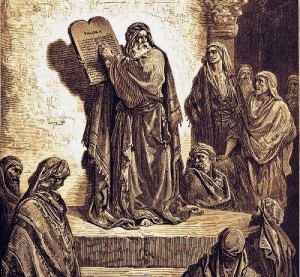Midrash and the Foundations of Jewish Law
Excerpted from Lawrence H. Schiffman, From Text to Tradition – A History of Second Temple & Rabbinic Judaism, Ktav Publishing House, Hoboken, NJ, 1991.
During the exile, a feeling of patriotism and the desire to preserve the Israelite literary heritage in the wake of the destruction of the ancestral homeland were probably responsible for a new emphasis on the study of Israel’s scriptures. When Ezra returned to Judea, he devoted himself to making the Torah the center of the religious life of his people. But the Torah had one deficiency as a legal text. There were apparent contradictions and inconsistencies between the legal rulings in its various sections. Now something new was called for. How were the contradictions between laws on the same subject to be handled? How were the multiple presentations of the same material to be
understood?
The duplications in the Torah begged to be interpreted. Thus was born the method which later Hebrew termed midrash. Essentially, the exegetical (interpretative) technique of midrash can be defined as the explanation of one biblical passage in the light of another. In its earliest forms midrash dealt with matters of Jewish law, what the rabbis later called halakhah. In the early Second Temple period, the new dependence on the written law stimulated the development of the method of legal midrash. Its earliest record is in the books of Ezra and Nehemiah.
An example of the use of this technique in our period is the decision attributed to Ezra to expel foreign wives. Returning exiles had married non-Israelite women of “the people of the land” and children had been born to them. Ezra 9-1 presents a list of the nations with which Israel had intermarried. The list is itself evidence of a midrashic interpretation. Included are some nations with which the Torah had prohibited marriage unconditionally and other nations that could marry Israelites only after a specific number of generations according to other biblical sources. The technique of analogical midrash led to the conclusion, based on Deut. 7-3 and 23-8–9, that the nations were all to be treated alike; marriage with any of them was to be eternally proscribed. The expulsion of the foreign wives was based on this exegetical conclusion.
Another example relates to the proper observance of Sukkot (Tabernacles). Leviticus 23 commands the building of the sukkah, and dwelling in it during the seven-day festival. There is no mention of pilgrimage to the sanctuary. Deuteronomy 16 does not mention the obligation of dwelling in sukkot but describes the festival as a pilgrimage. Legal midrash led to the decision that the entire people was to assemble in Jerusalem and build sukkot there. Thus it was possible to fulfill the commands of both codes and in this way resolve the inconsistency.
Other decisions based on this technique are recorded in the covenant of Nehemiah 10. These show beyond any doubt that the use of the midrashic method for the determination of Jewish law in cases where the Pentateuch was either unclear or apparently contradictory became the norm in the Persian period. It remained in use for the derivation of new conclusions until well into the Middle Ages, and at the same time, as we will see, often served as a means of justifying legal rulings already practiced on the basis of ancient tradition.
To avoid confusion one point should be made very clear – the term midrash designates both an exegetical method and a collection of literary materials based on midrashic exegesis. Later on we will have occasion to discuss various midrashim of the latter sort. It would be incorrect to conclude from the early dating of the technique of legal midrash that the contents of the collections to be examined later are of similar antiquity.




